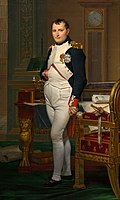French Government of the Hundred Days | |
|---|---|
| Cabinet of the First French Empire | |
 Napoleon I | |
| Date formed | 20 March 1815 |
| Date dissolved | 22 June 1815 |
| People and organisations | |
| Head of state | Napoleon |
| Head of government | Napoleon |
| History | |
| Predecessor | Government of the first Bourbon restoration |
| Successor | French Executive Commission of 1815 |
The French Government of the Hundred Days was formed by Napoleon I upon his resumption of the Imperial throne on 20 March 1815, replacing the government of the first Bourbon restoration which had been formed by King Louis XVIII the previous year. Following the defeat of Napoleon at the Battle of Waterloo and his second abdication on 22 June 1815 the Executive Commission of 1815 was formed as a new government, declaring the Empire abolished for a second time on 26 June.
